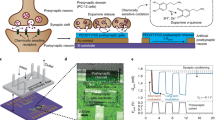Abstract
Neurological disorders affect millions of people which influence their cognitive and/or motor capabilities. The realization of a prosthesis must consider the biological activity of the cells and the connection between machine and biological cells. Biomimetic neural network is one solution in front of neurological diseases. The neuron replacement should be processed by reproducing the timing and the shape of the spike. Several mathematical equations which model neural activities exist. The most biologically plausible one is the Hodgkin–Huxley (HH) model. The connection between electrical devices and living cells require a tunable real-time system. The field programmable gate array (FPGA) is a nice component including flexibility, speed and stability. Here, we propose an implementation of HH neurons in FPGA serving as a presage for a modulating network opening a large scale of possibilities such as damage cells replacement and the study of the effect of the cells disease on the neural network.





Similar content being viewed by others
References
Nicolelis MAL, Lebedev MA (2009) Principles of neural ensemble physiology underlying the operation of brain–machine interfaces. Nat Rev Neurosci 10:530–540
Hochberg LR, Serruya MD, Friehs GM, Mukand JA, Saleh M, Caplan AH, Branner A, Chen D, Penn RD, Donoghue JP (2006) Neuronal ensemble control of prosthetic devices by a human with tetraplegia. Nature 442:164–171
Hochberg LR, Bacher D, Jarosiewicz B, Masse NY, Simeral JD, Vogel J, Haddadin S, Liu J, Cash SS, Van Der Smagt P, Donoghue JP (2012) Reach and grasp by people with tetraplegia using a neurally controlled robotic arm. Nat Methods 485:372–375
Bonifazi P, Difato F, Massobrio P, Breschi GL, Pasquale V, Levi T, Goldin M, Bornat Y, Tedesco M, Bisio M, Kanner S, Galron R, Tessadori J, Taverna S, Chiappalone M (2013) In vitro large-scale experimental and theoretical studies for the realization of bi-directional brain-prostheses. Front Neural Circuits 7:40
Levi T, Lewis N, Tomas J, Saighi S, Renaud S, Bornat Y, Alvado L (2008) Neuromimetic integrated circuits, Chap 12. In: Kris I (ed) VLSI circuits for biomedical applications. Artech House, Boston, pp 241–264
Mahowald M, Douglas R (1991) A silicon neuron. Nature 1991:515–518
Indiveri G et al (2001) Neuromorphic silicon neuron circuits. Front Neurosci 5:73
Levi T, Lewis N, Tomas J, Fouillat P (2008), IP-based methodology for analog design flow: application on neuromorphic engineering, NEWCAS-TAISA conference, pp 343–346
Indiveri G (2007) Synaptic plasticity and spike-based computation in VLSI networks of integrate-and-fire neurons. Neural Inf Process Lett Rev 11:135–146
Izhikevich EM (2003) Simple model of spiking neurons. IEEE Trans Neural Netw 14(6):1569–1572
Hodgkin AL, Huxley AF (1952) A quantitative description of membrane current and its applications to conduction and excitation in nerve. J Physiol 117:500–544
Cassidy A, Andreou AG (2008) Dynamical digital silicon neurons. In: IEEE biomedical circuits and systems conference, pp. 289–292, 20–22
Cassidy A, Andreou AG, Georgiou J (2011) Design of a one million neuron single FPGA neuromorphic system for real-time multimodal scene analysis. In: 45th Annual Conference CISS, 1–6
Basham EJ, Parent DW (2012) Compact digital implementation of a quadratic integrate-and-fire neuron. In: 34th Annual conference of the IEEE EMBS, 3543–3548
Ambroise M, Levi T, Joucla S, Yvert B, Saighi S (2013) Real-time biomimetic central pattern generators into FPGA for hybrid experiments. Front Neurosci 7:215
Grassia F, Levi T, Kohno T, Saighi S (2014) Silicon neuron: digital hardware implementation of the quartic model. J Artif Life Robot 19:215–219
Joucla S, Ambroise M, Levi T, Lafon T, Chauvet P, Saïghi S, Bornat Y, Lewis N, Renaud S, Yvert B (2016) Generation of locomotor-like activity in the isolated rat spinal cord using intraspinal electrical microstimulation driven by a digital neuromorphic CPG. Front Neurosci 10:67
Bonabi Y, Asgharian H, Safari S, Ahmadabadi M (2014) FPGA implementation of a biological neural network based on the Hodgkin–Huxley neuron model. Front Neurosci 8:379
Lu M, Wang J-L, Wen J, Dong X-W (2016) Implementation of Hodgkin–Huxlet neuron model in FPGAs. In: Asia-Pacific international symposium on electromagnetic compatibility, vol 1, pp 1115–1117
Mejia L, Litterman N, Ikeuchi Y, De la Torre-Ubieta L, Bennett E, Zhang C, Harper W, Bonni A (2013) A novel Hap1–Tsc1 interaction regulates neuronal mTORC1 signaling and morphogenesis in the brain. J Neurosci 33(46):18015–18021
Davison A, Feng J, Brown D (2000) A reduced compartmental model of the mitral cell for use in network models of the olfactory bulb. Brain Res Bull 51(5):393–399
Capogrosso M et al (2016) A brain–spine interface alleviating gait deficits after spinal cord injury in primates. Nature 539:284–288
Ambroise M, Buccelli S, Grassia F, Pirog A, Bornat Y, Chiappalone M, Levi T (2017) Biomimetic neural network for modifying biological dynamics during hybrid experiments. J Artif Life Robot 23:1–6
Acknowledgements
The research leading to these results has received funding from CNRS PEPS2015 “Neuroprotest”.
Author information
Authors and Affiliations
Corresponding author
About this article
Cite this article
Levi, T., Khoyratee, F., Saïghi, S. et al. Digital implementation of Hodgkin–Huxley neuron model for neurological diseases studies. Artif Life Robotics 23, 10–14 (2018). https://doi.org/10.1007/s10015-017-0397-7
Received:
Accepted:
Published:
Issue Date:
DOI: https://doi.org/10.1007/s10015-017-0397-7




